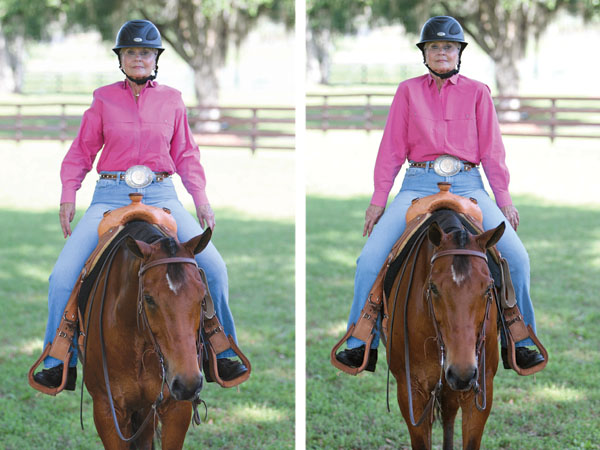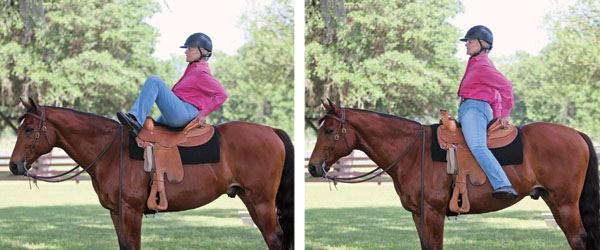Are you a rigid rider? Or do you sit in harmony with your horse? You can be sitting in a “perfect“ position, but still be incorrect—because you’re out of true connection with your horse. I know, because I see it all the time in the show pen. These riders look the part, but they’re like “pretty statues.” They’re not able to be relaxed and effective.
[RELATED: 4 HORSEMANSHIP MYTHS—BUSTED!]

Every year, the American Quarter Horse Association conducts a refresher course for its judges. At a recent one, the presenters stressed the difference in a horsemanship class between a rigid rider on a pushbutton horse, and a more effective rider that might be on a less-broke horse. The more effective rider was to get the nod, even if the rigid rider’s horse was flawless. Being effective, after all, is what true horsemanship is about.
What’s the difference between a correctly positioned but rigid rider, and one who sits a horse with fluidity, balance, and connection? I’m going to explain that difference. Then I’ll give you exercises that will help you become the connected, accomplished rider you wish to be—in the show pen or anywhere you ride.
Right & Wrong: A Comparison
The photos above and above-right show my demonstration rider sitting in harmony on her horse, and sitting in a similar position but with rigidity and lack of connection—something I see a lot in the show pen. Let’s break it down.
What’s right in the first photo: She’s sitting deep in the saddle, erect yet relaxed. Her facial expression is pleasant, and she’s looking with confidence in the direction she’s going.

Her shoulders are even and in a naturally “down” position. Correspondingly, her upper arms, elbows, and forearms are relaxed and able to move slightly to follow the motion of her horse’s head at a walk (or lope). Her hands are holding the reins closed, but in a soft, giving way.
Her back is straight but not arched, so her lower back and hips can follow the motion of her horse. Her legs drape softly down in the correct position, just behind the cinch. Her heels are lower than her toes.
Her horse is, as a result of her position, also relaxed and happy-looking.
What’s wrong in the second photo: Here my rider is in much the same general position, but with significant differences. She looks rigid, and isn’t sitting as deeply in the saddle as she is in the first photo. Her gaze is locked, giving her facial expression a look of harsh focus.
[RELATED: TRAIN YOUR BRAIN, BOOST YOUR RIDING]

She’s tight in her upper body. Her shoulders and arms are locked in position, which makes a fluid following of her horse’s movement impossible. Her shoulders are tensed slightly forward. (I also see riders tensing their shoulders upward—either way is wrong.) Her hands are tight and rigid, which blocks soft communication through the reins.
She’s locked through her back—again, no following the motion through the rider’s hips here. Her legs are pushed forward; see how her lower leg is on the cinch instead of just behind it? Riders do this when, instead of balancing through a deep, following seat, they try to balance on the balls of their feet, and/or by pushing too hard through their heels.
Her horse is showing some tension in his neck as a result of her stiffness. He’s trying to be tolerant, but I’d expect him eventually to begin moving his head to try to escape her rigid hands and arms.
Now let’s consider how you can avoid being a “pretty statue.”
Prepare to Ride Right
These exercises, practiced diligently over time, will help you become more like the image in the first picture, and less like the second. (Note: If there’s any doubt your horse will stand for you quietly, have a helper hold him as you perform these exercises.)
Shoulder Relaxer. Raise your shoulders as high as you can, then let them drop as low as they’ll go. Repeat several times until you feel the tension in your shoulders and neck dissolve. As you hold your shoulders rigidly up, note how the tension extends down through your arms, right to your hands. As you drop your shoulders into a natural position, note how much easier it is for your arms, elbows, wrists, and fingers to relax.

Upper-Back Relaxer. Draw your shoulders as far back as you can, pinching your shoulder blades together and stretching your chest muscles. Then pull your shoulders as far forward as you can, rounding your upper back and stretching those muscles. Repeat. This is an excellent tension reliever to get at the tightness in your upper body. It also helps you to realize what square shoulders should feel like. (Western riders often aren’t square; when they ride one-handed, the shoulder of the hand holding the reins often drops forward and/or down a bit.)

Lower-Back Relaxer. Push your stomach out as far as you can. Your lower back may arch slightly—that’s OK. Then draw your stomach in as far as you can, exhaling completely and really tightening in your abdominal muscles. Your lower back may round slightly—and that’s OK. Repeat. If you tend to arch your back too much, do more of stomach-in; if you tend to round your lower back, do more of stomach-out. Suppling your lower back in this manner makes it possible for your hips to move freely to follow your horse’s motion smoothly and consistently.
Balancer/Leg-Lengthener. Holding the back of the cantle and sitting on your seatbones, raise one knee up as high as you can, striving to maintain your own balance as you do so. Then kick that leg back as far as you can toward your horse’s hind legs, flexing your toe upward, and hold for a moment. Repeat with the other leg. This stretches your calf muscles, elongates your legs, and helps train you away from the tendency to ride with your legs too far forward.


Leg Relaxer. Holding the front of your saddle and sitting on your seatbones, draw both legs as far away from your horse’s sides as you can, hold for a moment, then relax and repeat. This stretches your inner-thigh muscles and enables you ultimately to sit deeper and more securely without leg-gripping. It also helps improve your balance. Once you’ve mastered it at a standstill, you can try it at a walk, trot, and even canter. (To maximize this exercise it must be done without stirrups, so I recommend doing it on a longe line.) It’s a challenging but highly rewarding exercise.

Lynn Palm is a multiple world champion who’s been providing sound horsemanship advice to riders for more than 40 years. She and her husband, Cyril Pittion-Rossillon, conduct clinics around the world and at their own Fox Grove Farm in Ocala, Florida (lynnpalm.com).






